Opossums are marsupials that belong to order Didelphimorphia in the Western Hemisphere.
Contents
Opossum or opossom may also refer to:
Opossums are marsupials that belong to order Didelphimorphia in the Western Hemisphere.
Opossum or opossom may also refer to:

Marsupials are any members of the mammalian infraclass Marsupialia. All extant marsupials are endemic to Australasia, Wallacea and the Americas. A distinctive characteristic common to most of these species is that the young are carried in a pouch. Living marsupials include opossums, Tasmanian devils, kangaroos, koalas, wombats, wallabies, and bandicoots among others, while many extinct species, such as the thylacine, are also known.

The Virginia opossum, also known as the North American opossum, is the only opossum living north of Mexico, its range extending south into Central America. It is the northernmost marsupial in the world. In the United States and Canada, it is typically called a possum, 'possum, or opossum. It is a solitary nocturnal animal about the size of a domestic cat, and a successful opportunist.

Moles are small mammals adapted to a subterranean lifestyle. They have cylindrical bodies, velvety fur, very small, inconspicuous eyes and ears, reduced hindlimbs, and short, powerful forelimbs with large paws adapted for digging.

Opossums are members of the marsupial order Didelphimorphia endemic to the Americas. The largest order of marsupials in the Western Hemisphere, it comprises 93 species in 18 genera. Opossums originated in South America and entered North America in the Great American Interchange following the connection of North and South America.

The family Caenolestidae contains the seven surviving species of shrew opossum: small, shrew-like marsupials that are confined to the Andes mountains of South America. The order is thought to have diverged from the ancestral marsupial line very early. They were once included in the superorder but it is now known that Ameridelphia is paraphyletic, having given rise to Australidelphia, and thus could be considered an evolutionary grade. Genetic studies indicate that they are the second most basal order of marsupials, after the didelphimorphs. As recently as 20 million years ago, at least seven genera were in South America. Today, just three genera remain. They live in inaccessible forest and grassland regions of the High Andes.

Linnaeus's mouse opossum, also known as the common or murine mouse opossum, is a South American marsupial of the family Didelphidae.

Ameridelphia is traditionally a superorder that includes all marsupials living in the Americas except for the Monito del monte (Dromiciops). It is now regarded as a paraphyletic group.

The water opossum, also locally known as the yapok, is a marsupial of the family Didelphidae. It is the only living member of its genus, Chironectes. This semiaquatic creature is found in and near freshwater streams and lakes from Mexico through Central and South America to Argentina and is the most aquatic living marsupial. It is also the only living marsupial in which both sexes have a pouch. The thylacine, commonly referred to as the Tasmanian tiger, also exhibited this trait, but it is now extinct.
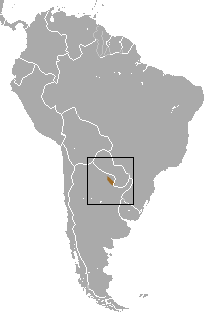
The Chacoan pygmy opossum is a recently described genus and species of didelphimorph marsupial. The only species in Chacodelphys, C. formosa, was known until 2004 from only one specimen collected in 1920 in the Chaco of Formosa Province, Argentina. The species is gaining popularity as a pocket pet.
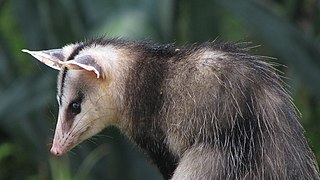
Didelphis is a genus of New World marsupials. The six species in the genus Didelphis, commonly known as Large American opossums, are members of the opossum order, Didelphimorphia.

The bushy-tailed opossum is an opossum from South America. It was first described by English zoologist Oldfield Thomas in 1912. It is a medium-sized opossum characterized by a large, oval, dark ears, fawn to cinnamon coat with a buff to gray underside, grayish limbs, and a furry tail. Little is known of the behavior of the bushy-tailed opossum; less than 25 specimens are known. It appears to be arboreal (tree-living), nocturnal and solitary. The diet probably comprises insects, eggs and plant material. This opossum has been captured from heavy, humid, tropical forests; it has been reported from Bolivia, Brazil, Colombia, Ecuador and Peru. The IUCN classifies it as least concern.
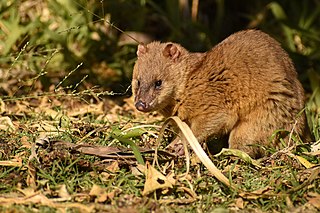
The big lutrine opossum, also called little water opossum, thick-tailed opossum and coligrueso, is a long-tailed, otter-like mammal native to grasslands of South America. It generally lives near water and is active at night, dawn or dusk. It eats mice, insects and crabs. Like all opossums, it is a marsupial.
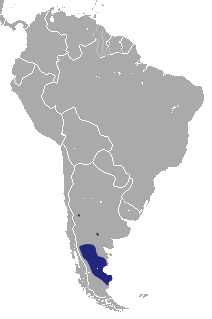
The Patagonian opossum(Lestodelphys halli) is the sole species in genus Lestodelphys.
Possum may refer to:
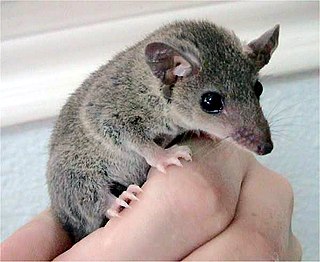
The gray short-tailed opossum is a small South American member of the family Didelphidae. Unlike most other marsupials, the gray short-tailed opossum does not have a true pouch. The scientific name Monodelphis is derived from Greek and means "single womb" and the Latin word domestica which means "domestic". It was the first marsupial to have its genome sequenced. The gray short-tailed opossum is used as a research model in science, and is also frequently found in the exotic pet trade. It is also known as the Brazilian opossum, rainforest opossum and in a research setting the laboratory opossum.
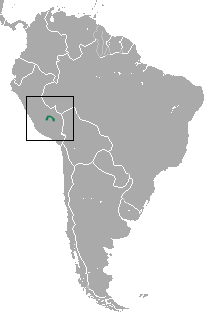
The heavy-browed mouse opossum, or Anderson's mouse opossum, is a species of opossum in the family Didelphidae. It is endemic to a restricted range in southern Peru. This opossum inhabits forests; it is nocturnal and probably arboreal.

The white-bellied fat-tailed mouse opossum is a species of opossum in the family Didelphidae. It is found in Argentina, Bolivia, Chile and Peru.

The gray-bellied caenolestid, or grey-bellied shrew opossum, is a shrew opossum found in humid, temperate forests and moist grasslands of western Ecuador and northwestern Peru. It was first described by American zoologist Harold Elmer Anthony in 1921. Little is known about the behavior of the gray-bellied caenolestid. It appears to be terrestrial (land-living) and crepuscular or nocturnal. Diet consists of invertebrate larvae, small vertebrates and plant material. The IUCN classifies the gray-bellied caenolestid as near threatened.
Pygmy opossum may refer to:

Peradectes is an extinct genus of small metatherian mammals known from the latest Cretaceous to Eocene of North and South America and Europe. The first discovered fossil of P. elegans, was one of 15 Peradectes specimens described in 1921 from the Mason pocket fossil beds in Colorado. The monophyly of the genus has been questioned.